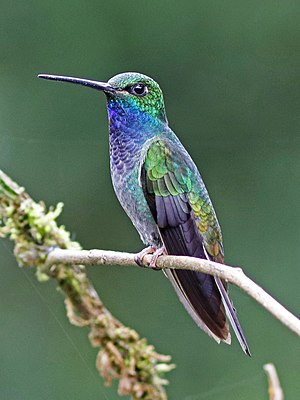Blue-throated Andean Hummingbird
| Blue-throated Andean Hummingbird | ||||||||||||
|---|---|---|---|---|---|---|---|---|---|---|---|---|

Blue-throated Andean Hummingbird |
||||||||||||
| Systematics | ||||||||||||
|
||||||||||||
| Scientific name | ||||||||||||
| Urochroa leucura | ||||||||||||
| Lawrence , 1864 |
The blue-throated Andean hummingbird ( Urochroa leucura ) is a species of bird from the hummingbird family (Trochilidae) that is found in Colombia , Ecuador and Peru . According to the IUCN, the population is not endangered ( Least Concern ). The species is considered to be monotypical .
features
The blue-throated Andean hummingbird, including its 3 cm beak, reaches a body length of about 13 to 14 cm, with a weight of 8.7 g. It is considered to be conspecific with the Orangean Andean Hummingbird ( Urochroa bougueri ( Bourcier , 1851)): Both sexes are similar. It has a long straight black beak. The top is bronze green. The throat and chest shimmer blue, the belly is dull gray. The central control springs are bronze, the others white. The outside flags are dark gray. Adult females appear a little more dull in color than the males. Young animals are similar to the adult animals, but have yellow-brown fringes on the head feathers.
Behavior and nutrition
The blue-throated Andean hummingbird probably gets its nectar like the Orangerachen-Andean hummingbird u. a. of plants of the genera Inga , Bomarien , Psammisia and Cavendishia . Insects catch the birds over rivers or in clearings in which they hunt them. The males set up food territories on nectar-rich inflorescences . When foraging, the birds are mostly alone within the forest in the lower to middle strata . Occasionally they also visit the treetops.
Reproduction
Little is known about the breeding biology of the blue-throated Andean hummingbird. One specimen was caught in a breeding mood in northeastern Peru in September.
Vocalizations
The singing probably consists of a continuous series of individual tsii , tsing or siuw tones, which are uttered at a frequency of 1 to 1.5 tones per second. The chant also includes twit sounds that are uttered in a repeated long sequence.
distribution and habitat
The blue-throated Andean hummingbird prefers mountain forests, forest edges and secondary vegetation - especially near rivers - at altitudes of 1600 to 2800 meters. Occasionally it is seen on bushy slopes in lower elevations, e.g. B. in Peru, where it occurs only at altitudes between 800 and 1500 meters.
migration
The blue-throated Andean hummingbird is usually considered a resident bird . It is believed that it occasionally migrates seasonally between high altitudes as a line bird .
Etymology and history of research
The first description of the Blue-throated hummingbirds Andes took place in 1864 by George Newbold Lawrence under the scientific name Urochroa leucura . The type specimen came from Ecuador. It was John Gould who introduced the new genus Urochroa in 1856 . The word "Urochroa" is composed of the Greek words "ourá ουρά " for "tail" and "chroa χρόα " for "color, complexion". The species name »leucura« derives from »leukouros λευκουρος « for »white tailed« and is a Greek word structure from »leukos λευκος « for »white« and »-ouros, oura -ουρος, ουρα « for »-tailed, tail«.
literature
- Josep del Hoyo , Nigel James Collar , Guy Maxwell Kirwan , Peter Boesman in: Josep del Hoyo, Andrew Elliott, Jordi Sargatal , David Andrew Christie , Eduardo de Juana: White-tailed Hillstar (Urochroa leucura) In: Handbook of the Birds of the World Alive . Lynx Edicions, Barcelona.
- James A. Jobling: Helm Dictionary of Scientific Bird Names . Christopher Helm, London 2010, ISBN 978-1-4081-2501-4 .
- George Newbold Lawrence: Descriptions of New Species of Birds of the Families Tanagridae, Cuculidae, and Trochilidae, with a Note on Panterpe insignis . In: Annals of the Lyceum of Natural History of New York . tape June 8 , 1864, p. 41-46 ( biodiversitylibrary.org ).
- John Gould: A monograph of the Trochilidæ, or family of humming-birds . tape 5 , delivery 12. Taylor and Francis, London 1856 ( biodiversitylibrary.org ).
- Frederick Herschel Waterhouse: The dates of publication of some of the zoological works of the late John Gould, FRS RH Porter, London 1885 ( biodiversitylibrary.org ).
Web links
- Urochroa leucura inthe IUCN Red List of Threatened Species 2019.1. Listed by: BirdLife International, 2016. Retrieved July 7, 2019.
- BirdLife International: Species Factsheet - White-tailed Hillstar ( Urochroa leucura ) . Retrieved July 7, 2019.
- Videos, photos and sound recordings of White-tailed Hillstar (Urochroa leucura) in the Internet Bird Collection
- Blue-throated Andean Hummingbird ( Urochroa leucura ) at Avibase; accessed on July 7, 2019.
- Urochroa leucura in the Integrated Taxonomic Information System (ITIS). Retrieved July 7, 2019.
- xeno-canto: Sound recordings - Blue-throated Andean Hummingbird ( Urochroa leucura )
- White-tailed Hillstar (Urochroa leucura) in the Encyclopedia of Life . Accessed July 7, 2019.
Individual evidence
Remarks
- ↑ According to Frederick Herschel Waterhouse, p. 55, Plate 57 appeared as part of Delivery 12 from 1856. Here Gould assigned the Orangerach Andean Hummingbird ( Urochroa bougueri ( Bourcier , 1851)) to the genus.